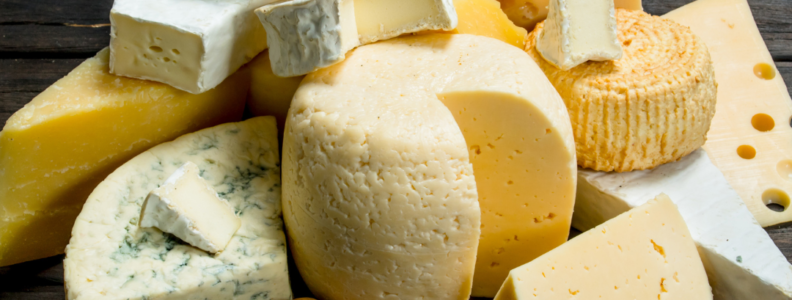Cheese, one of the world’s oldest and most beloved foods, has been around for centuries. We all know that there is a wide variety of cheeses available today, but did you know that it wasn’t until recently that so many different types have become readily available? In this blog post, we are going to take a look at the different types of cheese and how they vary in taste and texture. From soft and creamy Brie to hard and crumbly Parmesan, learn more about the delicious diversity of cheese.
The Different Flavors of Cheese
There are so many different flavors of cheese! How do you know which one to choose?
Here is a guide to the different flavors of cheese, so you can find the perfect one for your next meal.
- Blue Cheese: Blue cheese has a strong, tangy flavor that some people love and others find too intense. If you’re new to blue cheese, start with a milder variety like Gorgonzola.
- Brie: Brie is a soft, creamy cheese with a mild flavor. It’s often used in appetizers or as part of a cheese plate.
- Cheddar: Cheddar is a versatile cheese that comes in both Mild and Sharp varieties. Mild cheddar is great for sandwiches, while sharp cheddar is perfect for snacks or grating over salads.
- Feta: Feta is a salty, crumbly cheese that’s often used in Greek dishes. It has a strong flavor, so it’s best used in small amounts.
- Goat Cheese: Goat cheese has a tangy, slightly sweet flavor that pairs well with fruit or nuts. It comes in both soft and firm varieties.
- Gouda: Gouda is a smooth, buttery cheese with a nutty flavor. It’s great for melting on top of burgers or grilled sandwiches.
- Mozzarella: Mozzarella is a fresh, soft cheese with a mild flavor. It’s often used on pizza or in salads.
- Parmesan: Parmesan is a hard cheese with a sharp, nutty flavor. Grated Parmesan is great for sprinkling over salads or pasta dishes.
- Swiss: Swiss cheese has a mild, nutty flavor and distinctive holes throughout the cheese. It goes great in sandwiches or melted on top of casseroles.
Types of Cheese
In addition to the different flavors of cheese, there are also several types of cheese. Here is a guide to the different types of cheese:
- Soft Cheese: Soft cheeses, such as Brie and goat cheese, have a creamy texture and mild flavor. They’re perfect for spreading on crackers or adding to sandwiches and salads.
- Semi-Soft Cheese: Semi-soft cheeses, such as Gouda and Havarti, have a slightly firmer texture than soft cheeses. They’re great for melting in dishes or slicing for sandwiches.
- Firm Cheese: Firm cheeses, such as Cheddar and Swiss, have a dense texture and strong flavor. They can be grated over dishes or cubed for snacks.
- Hard Cheese: Hard cheeses, such as Parmesan and Asiago, have a crumbly texture and intense flavor. They’re perfect for grating over dishes like pasta or salad.
Cheese is one of the most versatile and delicious foods in the world. From soft and creamy Brie to hard and crumbly Parmesan, there is a cheese to suit everyone’s taste! With so many different types and flavors of cheese available, it can be overwhelming to choose the right one. Hopefully, this guide has helped you better understand the different types of cheese and how they vary in taste and texture.
Overview On How Cheese is Made
Cheese is a dairy product that is produced by curdling milk. The process of making cheese begins with separating the curds from the whey, which is done through a process of heating and adding rennet.
Once the curds are separated, they are then pressed into molds to form blocks of cheese. After the cheese has been formed, it is then aged to develop its flavor. Many different types of cheese are made using this basic process, but the type of milk that is used (e.g., cow, goat, sheep), as well as the addition of other ingredients, can create different flavors and textures.
Recipes With Cheese
Many recipes can be made with cheese as the main ingredient. Cheese can be used in savory dishes, like macaroni and cheese, or in sweet dishes, like cheesecake. Cheese can also be used as a topping on various dishes, like pizza or salads.
When choosing a recipe to make with cheese, it is important to consider the type of cheese that will be used. Some cheeses are better suited for certain dishes than others. For example, cheddar cheese is often used in macaroni and cheese because it has a strong flavor that pairs well with pasta. Meanwhile, ricotta cheese is often used in lasagna because it is light and fluffy.
No matter what dish you are making, there is likely a recipe that uses cheese as an ingredient. So get creative and experiment with different types of cheese in your cooking!
So, cheese is an ancient and versatile food that offers a range of flavors and textures to suit any taste. From mild cheddar to sharp blues, there’s something for everyone! With so many types of cheese available, it can be difficult to choose the right one for you.
But with this guide, we hope that you can now distinguish between the different types of cheeses out there and find your perfect match. Now go out and explore the wide world of cheeses!


